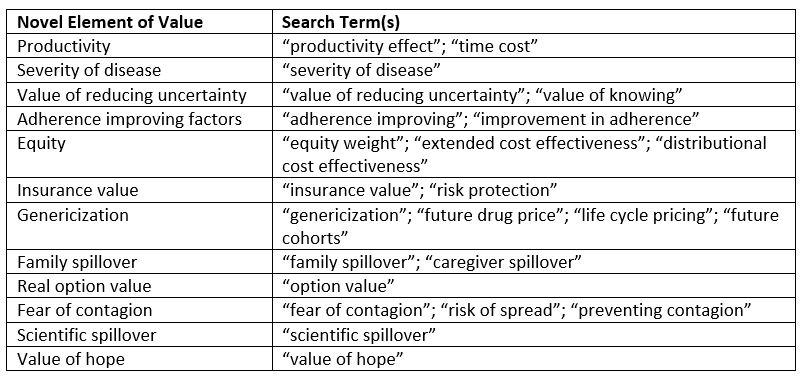By: Elliott Crummer, MA, Joshua Cohen, PhD, Peter Neumann, ScD
Introduction
In 2018 an ISPOR Special Task Force (STF) argued that conventional cost-effectiveness analyses may not account for a range of value elements and hence may understate the value conferred by health interventions. The STF advanced the notion of a “value flower”, with each petal representing one of the value elements.1 We have revised the data collection process for CEVR’s CEA Registry by adding questions about whether CEAs include some of these novel elements to the information we routinely collect when abstracting CEAs. We also investigated how often CEA authors have included novel elements in analyses published before 2021.
Updating the CEA Registry
CEVR launched a new CEA Registry website in early 2022. As part of this update, we now collect information on whether CEAs include novel value elements that the ISPOR task force included in their value flower (see list in Appendix Table A1). Users of the Registry can now search the database to identify CEAs that include specific novel elements. The Registry can also shed light on a range of research questions, including:
- How many CEAs include novel elements? Which elements do CEAs include most often?
- Are CEAs of certain types of interventions or diseases more likely to include novel elements?
- How does inclusion of a certain value element influence cost-effectiveness estimates?
Users with premium access to the CEA Registry can identify articles that include a specific value element using the “Social and Novel Elements of Value” post-search filter.
Establishing a Baseline
We sought to establish a baseline characterizing the inclusion of novel elements in CEAs prior to 2021. We searched the text of CEAs published from 2016 to 2020 for key words and phrases indicating use of a novel element, including phrases from ISPOR’s value flower paper1 (Appendix Table A1).
After identifying candidate CEAs, we reviewed each article’s full text to determine if the CEAs included a novel element in their cost-effectiveness ratio calculations or simply discussed the novel element (Figure 1).

We identified 30 CEAs, representing about 1 percent of CEAs published from 2016 to 2020, that include a novel element in their ratio calculation. We also analyzed how novel elements influenced cost-effectiveness estimates in 15 articles that report ratios calculated both with and without inclusion of the novel element. In some cases, inclusion of a novel element substantially influenced the ratio value, including examples for which inclusion reduced the ratio from a value exceeding the commonly used $100,000 per QALY benchmark to a value below this benchmark.
Discussion
Given the time it takes for new methods to diffuse and for articles to be published, it is not surprising to find that few CEAs include the novel elements of value described by the ISPOR Special Task Force. It is likely that other value element catalogs (alternative value flowers) will emerge and that ISPOR’s will evolve as the field continues to adopt these methods. More empirical evidence has been published to support the value elements, but more work is needed to make them standard practice2. The CEA Registry now tracks adoption of ISPOR’s value elements, and we will revise our data collection process when necessary to include any new value elements.
References
1 Lakdawalla DN, Doshi JA, Garrison LP, Phelps CE, Basu A, Danzon P. Defining Elements of Value in Health Care—A Health Economics Approach: An ISPOR Special Task Force Report [3]. Value Health. 2018 Feb 1;21(2):131-139. https://doi.org/10.1016/j.jval.2017.12.007
2 Neumann PJ, Garrison LP, Willke RJ. The History and Future of the “ISPOR Value Flower”: Addressing Limitations of Conventional Cost-Effectiveness Analysis. Value Health. 2022 Apr1;25(4):558-565. https://doi.org/10.1016/j.jval.2022.01.010
Appendix
Table A1: Search Terms Used to Identify Novel Elements of Value

